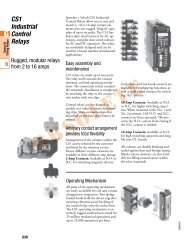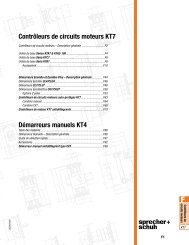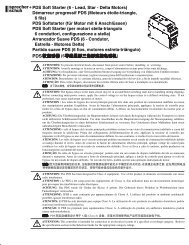Methods of Applying Circuit Protection - E-Catalog - Sprecher + Schuh
Methods of Applying Circuit Protection - E-Catalog - Sprecher + Schuh
Methods of Applying Circuit Protection - E-Catalog - Sprecher + Schuh
You also want an ePaper? Increase the reach of your titles
YUMPU automatically turns print PDFs into web optimized ePapers that Google loves.
<strong>Methods</strong><strong>of</strong> <strong>Applying</strong>CIRCUITPROTECTIONThis information is provided to aid in proper system design and utilization <strong>of</strong> circuitprotection devices in North American applications. Be sure to consider all applicablelocal and national codes for your particular installation.MCirciut <strong>Protection</strong>SSNA2014visit www.sprecherschuh.com/ecatalog for the most up to date informationM33
<strong>Circuit</strong> <strong>Protection</strong> <strong>Methods</strong>Series L8 Supplementary Protectors<strong>Applying</strong> L8 Supplementary Protectors in accordance with UL & NEC GuidelinesM<strong>Circuit</strong> <strong>Protection</strong><strong>Sprecher</strong>+<strong>Schuh</strong> Series L8 Supplementary Protectors are recognized byUnderwriters Laboratories (UL). Representative samples <strong>of</strong> this producthave been evaluated by UL and meet applicable US safety standards. Ingeneral, the UL Component Recognition service covers the evaluation <strong>of</strong>components that will later be used in a complete product or system. L8Supplementary Protectors are defined as UL Recognized supplementaryovercurrent protective devices under the standard <strong>of</strong> UL 1077.UL 508A, a procedure covering industrial control panels, <strong>of</strong>fers guidelinesin applying supplementary overcurrent protective devices. The general areas<strong>of</strong> acceptability are in the primary and secondary protection <strong>of</strong> controltransformers, and also control circuit protection. Other uses <strong>of</strong> Mini-CB’smay be submitted to UL for further investigation.Per UL 508A, before utilizing a supplementary device for controltransformer overcurrent protection, the supplementary device mustmeet the following restrictions:Unless otherwise specified it is used with protection, either fuseor circuit breakers upstream from the supplementary device, ratedat 400 percent <strong>of</strong> the supplementary protector rating but not lessthan 20A for device rated 150V or less and 15A for devices rated150V or more.(Reference: UL 508A procedure prescribed only)<strong>Protection</strong> <strong>of</strong> Control TransformersControl transformers can generate an almost infinite current spike onstart-up while attempting to overcome core saturation. Only the resistance<strong>of</strong> the control transformer windings and the inductance <strong>of</strong> the circuitlimit the large current draw. The inrush spikes are <strong>of</strong> short duration(1/8 to 1/4 <strong>of</strong> a cycle), typically reaching between 8~20 x I n . Therefore,selecting a Mini-CB with the proper current rating and high inrush tripcharacteristics is ideal to avoid nuisance tripping. <strong>Sprecher</strong>+<strong>Schuh</strong> SeriesL8 “C” & “D” type Supplementary Protectors <strong>of</strong>fer high inrush capabilitiesfrom 5~10 x I n and 10~20 x I n respectively.Selecting the proper Mini-CB current ratings for the primary and secondaryprotection <strong>of</strong> control transformers (per UL/NEC) is as follows:Primary Overcurrent <strong>Protection</strong> for Control TransformersControl <strong>Circuit</strong>s: If the rated primary current is less than 2 amps,the maximum rating <strong>of</strong> the overcurrent device is 500%. If the ratedprimary current is more than 2 amps, the maximum rating <strong>of</strong> theovercurrent device is 250%.(Reference: UL 508 32.7, UL 845 11.16 & 11.17, NEC 430-72(c) exception No. 2, 450-3(b) 1 & 2)Example (see table for more calculated results)Primary & Secondary <strong>Protection</strong> <strong>of</strong> a Control Transformer:50VA Pri. 480/ Sec. 120VPrimary Mini-CB Selection• 50VA/480V = 0.10A rated transformer primary current• 0.10A is less than 2, therefore may increase up to 500%• 0.10A x 500% = 0.52A, Select L8-.5/2/D (0.5 amp 2-Pole)• Upstream BCPD must be rated at 400% <strong>of</strong> the selected Mini-CBrating• 0.5A x 400% = 2A, since rated below 15A at 150V or more, theminimum BCPD is 15A per NEC-240.6Primary Control Transformer Calculations (480 / 240V)TransformerVAPrimaryVoltsRatedAmps ➊SelectedL8 Mini-CBMaximumUpstreamBCPD ➋50 480 0.10 0.5 15A100 480 0.21 1 15A150 480 0.31 1 15A200 480 0.42 2 15A250 480 0.52 2 15A300 480 0.63 3 15A500 480 1.04 5 25A1000 480 2.08 5 25A50 240 0.21 1 15A100 240 0.42 2 15A150 240 0.63 3 15A200 240 0.83 4 15A250 240 1.04 5 25A300 240 1.25 6 25A500 240 2.08 5 25A1000 240 4.17 10 60ASecondary Overcurrent <strong>Protection</strong> for Control TransformersControl <strong>Circuit</strong>s: If the rated secondary current is less than 9 amps,the maximum rating <strong>of</strong> the overcurrent device is 167%. If 9 amps ormore, the maximum rating <strong>of</strong> the overcurrent device is 125%. Thenext larger size <strong>of</strong> an overcurrent device may be used if 125% does notcorrespond to a standard size.➊ If the rated primary current is less than 2 amps, the maximum rating <strong>of</strong> theovercurrent device is 500%. If the rated primary current is more than 2 amps, themaximum rating <strong>of</strong> the overcurrent device is 250%.➋ Minimum standard BCPD ampere rating is 15A per NEC-240.6.M34visit www.sprecherschuh.com/ecatalog for the most up to date informationSSNA2014
<strong>Circuit</strong> <strong>Protection</strong> <strong>Methods</strong>Series L8 Supplementary Protectors<strong>Applying</strong> L8 Supplementary Protectors in accordance with UL & NEC Guidelines (continued)Secondary Supplementary Protectors Selection• 50VA/120V = 0.42A rated transformer secondary current• 0.42A is less than 9, therefore may increase up to 167%• 0.42A x 167% =0.70A, Select L8-1/1/D or L8-1/1/C(1 amp 1-Pole)Secondary Control Transformer Calculations (120 / 24V)TransformerVASecondaryVoltsRatedAmps ➊SelectedL8 Mini-CB50 120 0.42 1100 120 0.83 2150 120 1.25 2200 120 1.67 3250 120 2.08 4300 120 2.50 4500 120 4.17 71000 120 8.33 1350 24 2.08 4100 24 4.17 7150 24 6.25 10200 24 8.33 13250 24 10.42 13300 24 12.50 16500 24 20.83 301000 24 41.67 50<strong>Protection</strong> <strong>of</strong> Control <strong>Circuit</strong> DevicesControl circuit devices can also generate inrush currents during startup,though not as intense as control transformers. Devices such as controlrelays, starter coils, and solenoids exhibit typical inrush levels between6~10 x In. Also, protection <strong>of</strong> conductor wires or low-level signal devicessuch as PLCs may exhibit even lower inrush levels ranging from 3~5 xIn. Depending on the inrush, an Mini-CB with a type “B” or “C” tripcharacteristic will perform the task.Control <strong>Circuit</strong> Conductor <strong>Protection</strong>The relationship between the control circuit conductor size and rating <strong>of</strong> theprotective device must be in compliance with the tabulated data per UL 508.(Reference: UL 508A procedure prescribed only)Where can supplementary overcurrentprotectors not be used?• Branch <strong>Circuit</strong> <strong>Protection</strong> Device (BCPD)• Power Transformer Primary <strong>Protection</strong>• Power Transformer Secondary <strong>Protection</strong>• <strong>Protection</strong> <strong>of</strong> Loads such as for Motors, Heater, Lamps, and GeneraluseSupplementary protectors may be submitted to UL for further investigationfor other uses.MCirciut <strong>Protection</strong>➊ If the rated secondary current is less than 9 amps, the maximum rating <strong>of</strong> theovercurrent device is 167%. If 9 amps or more, the maximum rating <strong>of</strong> theovercurrent device is 125%.M35SSNA2014visit www.sprecherschuh.com/ecatalog for the most up to date information
<strong>Circuit</strong> <strong>Protection</strong> <strong>Methods</strong>Series L9 UL489 Miniature <strong>Circuit</strong> Breakers<strong>Applying</strong> L9 UL489 Miniature <strong>Circuit</strong> Breakers in accordance with UL & NEC Guidelines (continued)DescriptionL9 <strong>Circuit</strong> Breakers for Branch <strong>Circuit</strong> protection are available one (1)-,two (2-), and three (3-) pole construction and are rated 0.5 to 63A at240VC AC and 0.5 to 40A at 480Y/277V AC (D Curve to 35A) forNorth American applications (UL 489 and CSA 22.2 No. 5.1). For IECapplications, the products are rated 415V AC 0.5 to 63A.Thermal Magnetic <strong>Circuit</strong> BreakersThe L9 Thermal Magnetic <strong>Circuit</strong> Breakers are general-purpose devicessuitable for the majority <strong>of</strong> industrial, inverse time circuit breaker applications.They combine thermal and magnetic trip actions and provideaccurate overload and short-circuit protection for conductors and connectedequipment.<strong>Circuit</strong> Breaker Application InformationSelection <strong>of</strong> a L9 circuit breaker with appropriate circuit protectionincludes consideration <strong>of</strong>:● <strong>Circuit</strong> Voltage● <strong>Circuit</strong> Frequency● Available Short <strong>Circuit</strong> Current● Continuous Current Rating● Application Considerations● Special Operating ConditionsAvailable Short <strong>Circuit</strong> CurrentThe L9 circuit breakers should only be applied in those applications inwhich the available short-circuit (or fault) current is less than or equal to10 kA (US/Canada) and 15 kA (IEC).Region Max. Voltage Current Range253V AC (1-pole)0.5...63A440V AC (2-/3-pole)IEC Regions48V DC (1-pole)0.5...63A96V DC (2-/3-pole)240V AC0.5...63ANorth America (UL 489& CSA 22.2 No. 5.1)480Y/277V AC 0.5...40A (D Curve to 35A)1-pole 48V DC2-pole 96V DCTripping Characteristics0.5...63A0.5...63AThe trip curve characteristics are shown on the following pages. Thetrip bands shown for each breaker represent current tripping limits for acircuit breaker and are within the limits established by UL.The standard tripping characteristic for L9 circuit breakers is Type C.Type C has a magnetic trip activated at 5-10 times the rated current <strong>of</strong>the circuit breaker. The reference temperature for the thermal trippingcharacteristics is 30 °C. The Type C characteristic will suit most applications.M<strong>Circuit</strong> <strong>Protection</strong><strong>Circuit</strong> VoltageThe L9 circuit breakers are rated by voltage class. Applications should notexceed the listed voltage and current range.<strong>Circuit</strong> FrequencyThe L9 circuit breakers may be applied to frequencies <strong>of</strong> 50 and 60 Hzwithout derating. For applications above 60 Hz, contact <strong>Sprecher</strong> + <strong>Schuh</strong>with specific application information for the derating <strong>of</strong> the circuit breakers.In rare occurrences when the Type C characteristic does not fully meetthe application, Type D magnetic trip characteristic is available, allowingfor transients approximately twice as high as the standard Type C.For a specific current at 30 °C, a circuit breaker will open ("clear the circuit")automatically at some total time that will be within the minimumand maximum time shown on the curves. For example, a one-pole, 15 A,L9 circuit breaker trips in not less than 1 s and not more than 200 s ona 30 A current. Because the UL standard defines this time spread, usersshould not specify exact tripping time. The lower current portion <strong>of</strong> thecurves (upper left) depicts the time to trip due to thermal action andreflect overload protection <strong>of</strong> the wire and connect load. The higher currentportion <strong>of</strong> the curves (lower right) depicts the trip due to magneticaction <strong>of</strong> the circuit breaker and reflects protection due to short circuitlevel currents.M36visit www.sprecherschuh.com/ecatalog for the most up to date informationSSNA2014
<strong>Circuit</strong> <strong>Protection</strong> <strong>Methods</strong>Series L9 UL489 Miniature <strong>Circuit</strong> Breakers<strong>Applying</strong> L9 UL489 Miniature <strong>Circuit</strong> Breakers in accordance with UL & NEC Guidelines (continued)Application ConsiderationsThe selection <strong>of</strong> a specific ampere rating for a specific application isdependent on the type <strong>of</strong> load and duty cycle and is governed by the NationalElectric Code (Canadian Electric Code) and UL/CSA. In general,the codes require that overcurrent protection is at the current supply andat points where wire sizes are reduced. In addition, the codes state thatconductors be protected according to their current carrying capacity.There are specific situations that require application consideration, suchas motor circuit, and guidelines for the selection for transformer protection.The L9 circuit breakers are “non 100% rated” as defined UL 489, para7.1.4.2. As such, the circuit breaker's rating should be loaded to no morethan 80% if used with continuous loads.Branch <strong>Circuit</strong>sL9 circuit breakers may be used to protect branch circuits. A branchcircuit is the wiring portion <strong>of</strong> a system extending beyond the finalovercurrent device protecting the circuit. Guidelines established in NEC,CED, UL and CSA should be used to determine the specific device.1. Motor Branch <strong>Circuit</strong>L9 circuit breakers are not horsepower rated because they areable to safely interrupt currents far in excess <strong>of</strong> the locked rotorvalue for a selected motor. This ability is recognized in the codesand standards and is also established by the UL and CSA testsdescribed in UL 489 and CSA 22.2 No 5.1 standards.2. Transformer <strong>Protection</strong>L9 circuit breakers may be used for transformer protection followingthe guidelines established. References: NEC 450 and UL 489.Also see CEC and appropriate Canadian Standards. References:NEC 450 and UL 489. Also see CEC and appropriate CanadianStandards.3. Heater Load, Lighting, and Other Load <strong>Protection</strong>L9 circuit breakers may be used for protection <strong>of</strong> heater loads,lighting loads and other loads following the guidelines established.References: NED Article 31 and UL 508A. Also see CEC andappropriate Canadian Standards.Coordinated Overcurrent <strong>Protection</strong>Where an orderly shutdown is required to minimize the hazards topersonnel and equipment, a system <strong>of</strong> coordination based upon thefaulted or overloaded circuit is isolated by selective operation <strong>of</strong> only theovercurrent protective device closest to the overcurrent condition. Theuser should select devices that meet this requirement. References: NEC240.12. Also see CEC.HACR RatingL9 <strong>Circuit</strong> Breakers are rated as Heating, Air Conditioning and Refrigerationcircuit breakers as defined by UL489, paragraph 6.7 and may beused in this type <strong>of</strong> application.SWD RatingL9 breakers (0.5 ... 20A) are rated as SWD and as such may be appliedto switch fluorescent lighting loads up to their current and voltagemaximum.Current LimitingL9 <strong>Circuit</strong> Breakers are rated as current limiting circuit breakers as definedby UL 489, paragraph 8.6.The L9 line features the ability to achieve short circuit interruptionsfar more effectively than conventional breakers. In conventional circuitbreakers, the short circuit interruption time required is approximatelyone or two half cycles <strong>of</strong> an AC sine wave. When the contacts open, theresulting arc continues to burn until the current level passes throughzero. The arc may re-ignite because <strong>of</strong> the insufficient width <strong>of</strong> thecontact gap. The current that flows until the arc is extinguished producesa heating effect proportional to the I 2 t value (let-through-energy) <strong>of</strong> thefault current.The L9 device is designed to substantially reduce the amount <strong>of</strong> letthrough-currentand the resulting let-through-energy that can damageprotected components. The L9 has the ability to interrupt short circuitcurrent within the first half cycle <strong>of</strong> the fault. Limiting letthrough currentand energy will protect against the harmful effects <strong>of</strong> overcurrent and isfocused primarily on avoiding the following:• Excessive Heat• Mechanical DamageBoth <strong>of</strong> these factors are proportional to the square <strong>of</strong> the current. Thermalenergy is proportional to the square <strong>of</strong> the RMS value and magneticforces are proportional to the square <strong>of</strong> the peak value. The most effectiveway to provide protection is to substantially limit letthrough-energy. Thisprovides the following advantages• Far less damage at the location <strong>of</strong> the short circuit.• Fast electric separation <strong>of</strong> a faulty unit from the system, especiallypower supplies connected in parallel that are switched <strong>of</strong>f whenthe voltage <strong>of</strong> the power bus drops below a certain level.• Far less wear on the miniature circuit breaker itself. This meansmore safe interruptions.• Better protection <strong>of</strong> all components in the short circuit path.• Far wider range <strong>of</strong> selective action when used with an upstreamprotective device. (No nuisance shut downs from feeder line interruptions,causing a blackout in all connected branches.)MCirciut <strong>Protection</strong>M37SSNA2014visit www.sprecherschuh.com/ecatalog for the most up to date information
<strong>Circuit</strong> <strong>Protection</strong> <strong>Methods</strong>Series L9 UL489 Miniature <strong>Circuit</strong> Breakers<strong>Applying</strong> L9 UL489 Miniature <strong>Circuit</strong> Breakers in accordance with UL & NEC Guidelines (continued)Ambient Temperature DeratingsThe L9 circuit breakers are rated in RMS amperes at a 40 °C (104 °F) ambient temperature per UL 489/CSA C22.2 No. 5. This temperature is usedas the ambient temperature external to an industrial enclosure. If a circuit breaker is applied in a temperature that exceeds the 40 °C (104 °F) ambientrating, then the circuit breaker should be derated using the table below. For IEC 60947-2 standard, the products carry an ambient rating <strong>of</strong> 30 °C.Follow standard IEC application considerations for temperature rating in different ambient temperatures.Note: Application below 0º C is for non-condensing atmosphere. Care should be taken for applications below 0 °C. These devices are not certified tooperate correctly in the presence <strong>of</strong> ice.M<strong>Circuit</strong> <strong>Protection</strong>Temperature Derating, ULReference temperature = 40 °CCurrentRatingAmbient temperature (°C)[A] -25 -20 -10 0 10 20 30 40 50 550.5 0.6 0.6 0.6 0.6 0.6 0.5 0.5 0.5 0.5 0.51 1.2 1.2 1.2 1.1 1.1 1.1 1.0 1 1.0 0.91.6 2.0 2.0 1.9 1.8 1.8 1.7 1.7 1.6 1.5 1.52 2.5 2.4 2.4 2.3 2.2 2.1 2.1 2 1.9 1.93 3.7 3.7 3.6 3.4 3.3 3.2 3.1 3 2.9 2.84 5.0 4.9 4.7 4.6 4.4 4.3 4.1 4 3.9 3.85 6.2 6.1 5.9 5.7 5.6 5.4 5.2 5 4.8 4.76 7.4 7.3 7.1 6.9 6.7 6.4 6.2 6 5.8 5.77 8.7 8.6 8.3 8.0 7.8 7.5 7.3 7 6.7 6.68 9.9 9.8 9.5 9.2 8.9 8.6 8.3 8 7.7 7.610 12.4 12.2 11.9 11.5 11.1 10.7 10.4 10 9.6 9.413 16.1 15.9 15.4 14.9 14.4 14.0 13.5 13 12.5 12.315 18.6 18.3 17.8 17.2 16.7 16.1 15.6 15 14.4 14.216 19.8 19.6 19.0 18.4 17.8 17.2 16.6 16 15.4 15.120 24.8 24.4 23.7 23.0 22.2 21.5 20.7 20 19.3 18.925 31.0 30.6 29.6 28.7 27.8 26.9 25.9 25 24.1 23.630 37.2 36.7 35.6 34.4 33.3 32.2 31.1 30 28.9 28.332 39.7 39.1 37.9 36.7 35.6 34.4 33.2 32 30.8 30.235 43.4 42.8 41.5 40.2 38.9 37.6 36.3 35 33.7 33.140 49.6 48.9 47.4 45.9 44.4 43.0 41.5 40 38.5 37.850 62.0 61.1 59.3 57.4 55.6 53.7 51.9 50 48.2 47.260 74.4 73.3 71.1 68.9 66.7 64.4 62.2 60 57.8 56.763 78.2 77.0 74.7 72.3 70.0 67.7 65.3 63 60.7 59.5Temperature Derating, IECReference temperature = 30 °CCurrentRatingAmbient temperature (°C)[A] -25 -20 -10 0 10 20 30 40 50 550.5 0.6 0.6 0.6 0.5 0.5 0.5 0.5 0.5 0.5 0.51 1.2 1.2 1.1 1.1 1.1 1.0 1 1.0 0.9 0.91.6 1.9 1.8 1.8 1.7 1.7 1.6 1.6 1.6 1.5 1.52 2.3 2.3 2.2 2.2 2.1 2.1 2 1.9 1.9 1.93 3.5 3.5 3.4 3.3 3.2 3.1 3 2.9 2.8 2.84 4.7 4.6 4.5 4.4 4.2 4.1 4 3.9 3.8 3.75 5.8 5.8 5.6 5.5 5.3 5.2 5 4.9 4.7 4.66 7.0 6.9 6.7 6.5 6.4 6.2 6 5.8 5.6 5.67 8.2 8.1 7.8 7.6 7.4 7.2 7 6.8 6.6 6.58 9.3 9.2 9.0 8.7 8.5 8.2 8 7.8 7.5 7.410 11.7 11.5 11.2 10.9 10.6 10.3 10 9.7 9.4 9.313 15.1 15.0 14.6 14.2 13.8 13.4 13 12.6 12.2 12.015 17.5 17.3 16.8 16.4 15.9 15.5 15 14.6 14.1 13.916 18.6 18.4 17.9 17.4 17.0 16.5 16 15.5 15.0 14.820 23.3 23.0 22.4 21.8 21.2 20.6 20 19.4 18.8 18.525 29.1 28.8 28.0 27.3 26.5 25.8 25 24.3 23.5 23.130 35.0 34.5 33.6 32.7 31.8 30.9 30 29.1 28.2 27.832 37.3 36.8 35.8 34.9 33.9 33.0 32 31.0 30.1 29.635 40.8 40.3 39.2 38.2 37.1 36.1 35 34.0 32.9 32.440 46.6 46.0 44.8 43.6 42.4 41.2 40 38.8 37.6 37.050 58.3 57.5 56.0 54.5 53.0 51.5 50 48.5 47.0 46.360 69.9 69.0 67.2 65.4 63.6 61.8 60 58.2 56.4 55.563 73.4 72.5 70.6 68.7 66.8 64.9 63 61.1 59.2 58.3M38visit www.sprecherschuh.com/ecatalog for the most up to date informationSSNA2014
<strong>Circuit</strong> <strong>Protection</strong> <strong>Methods</strong>Series L9 UL489 Miniature <strong>Circuit</strong> BreakersTripping CharacteristicsC CurveD CurveMCirciut <strong>Protection</strong>SSNA2014visit www.sprecherschuh.com/ecatalog for the most up to date informationM39
<strong>Circuit</strong> <strong>Protection</strong> <strong>Methods</strong>Series L8 and L9Defining Electrical Standards Relating to <strong>Protection</strong> Devices➊➋➎➌➏➐➐➊ Branch <strong>Circuit</strong> <strong>Protection</strong> Device (BCPD)Acceptable components• Branch circuit protection device (UL489)• Self-protected Type E manual motor controller (UL508-E)➋ Control Transformer Primary <strong>Protection</strong>Acceptable components• UL-listed fuses (UL512)• Branch circuit protection device (UL489)• Supplementary protective device (UL1077)➍➊L11 Disconnect Switch<strong>Sprecher</strong> + <strong>Schuh</strong> Products➌➍V7 Fuse BlocksM<strong>Circuit</strong> <strong>Protection</strong>➌ Control Transformer Secondary <strong>Protection</strong>Acceptable components• Supplementary protective device (UL1077)• Miscellaneous, miniature and micro fuses➍ Supplementary <strong>Circuit</strong> <strong>Protection</strong>Acceptable components• Supplementary protective device (UL1077)• Branch circuit protection device (UL489)• Miscellaneous, miniature and micro fuses➎ Power Transformer Fuse/Branch <strong>Circuit</strong> <strong>Protection</strong>Acceptable components• Branch circuit protection device or power-relatedtransformer fuses (UL489/512)➏ Power Transformer Fuse/Branch <strong>Circuit</strong> <strong>Protection</strong>Acceptable components• Branch circuit protection device or power-relatedtransformer fuses (UL489/512)➐ Motor Load <strong>Protection</strong>• Manual motor controllers (UL508-E)➋➌➍➊➏➐KT7 Motor <strong>Circuit</strong> ProtectorL8 Supplementary Protector➊➋➌➍➎➏➊➋➌➍➎➏L9 Miniature <strong>Circuit</strong> BreakerKTU7 Molded Case <strong>Circuit</strong> breaker➋➌➍➎➏Ambus Fuse HolderM40visit www.sprecherschuh.com/ecatalog for the most up to date informationSSNA2014
<strong>Circuit</strong> <strong>Protection</strong> <strong>Methods</strong>Series L8 and L9Defining Electrical Standards Relating to <strong>Protection</strong> Devices<strong>Circuit</strong> protection devices should be applied in accordance with theproduct specifications, as well as local and national electrical codes.<strong>Sprecher</strong>+<strong>Schuh</strong> protection devices <strong>of</strong>fer equipment manufacturers aproduct that meets both US and international protection standards.A variety <strong>of</strong> <strong>Sprecher</strong>+<strong>Schuh</strong> <strong>Protection</strong> Devices are approved byUnderwriters Laboratory’s standards and are applicable for use underthe guidelines <strong>of</strong> the National Electric Code (NEC). Internationally,<strong>Sprecher</strong>+<strong>Schuh</strong> <strong>Protection</strong> Devices are CE marked and meet CSA andIEC standards for worldwide acceptance.<strong>Sprecher</strong>+<strong>Schuh</strong> <strong>Protection</strong> Devices are an excellent choice for a widevariety <strong>of</strong> electrical protection circuits. See the listings below to gain abroader understanding <strong>of</strong> additional electrical standards pertaining toother types <strong>of</strong> circuit protection.UL 508 Manual Motor ControllersA manual motor controller is suitable for use as an ON/OFF(make/break) controller for motors and other loads. Thesedevices also have an overload tripping function which must becompliant with applicable tests for an overload relay. In addition, anoverload tripping device must operate independently <strong>of</strong> the manipulation<strong>of</strong> the handle (trip free).A listed Manual Motor Controller, additionally marked “Suitable as aMotor Disconnect,” shall be permitted as a disconnecting means whereinstalled between the final motor branch-circuit short-circuit, transformerprotection, device and the motor. General uses: control circuit,transformer protection, motor loads, general use loads, lighting loads,resistive loads.Although <strong>Sprecher</strong>+<strong>Schuh</strong> Supplementary Protectors are not listed asUL 508 manual motor controllers, <strong>Sprecher</strong> + <strong>Schuh</strong> <strong>of</strong>fers our KT7Motor Controller series, which does meet the UL 508 standard at acompetitive price.CSA C22.2 No. 5.1Products evaluated according to the Canadian Standards®Association (CSA), which are intended to protect branch circuitsin accordance with the Canadian Electric Code (CEC). The CSA C22.2No. 5.1 standard is closely related to the UL 489 standard.UL 1077 Supplementary <strong>Protection</strong>UL recognized supplementary protectors evaluated accordingto UL 1077 standard. Supplementary protectors are intendedfor use as overcurrent protection within an appliance or other electricalequipment where branch circuit protectors shall not be used as substitutesfor UL 489 branch circuit protective devices. General uses: controlcircuit components such as relay coils, starter coils, timers and remotesolenoids... etc.; control transformers protection (primary & secondary);sensitive internal electronic circuitry.CSA C22.2 No. 235The CSA C22.2 No. 235 Standard is closely related to the®UL 1077 Supplementary Protector standard.IEC 60947-2 StandardElectrical standards for industrial applications using circuitprotection.UL 489 Branch <strong>Circuit</strong> <strong>Protection</strong>Products UL Listed for Branch <strong>Circuit</strong> <strong>Protection</strong>, which areapproved and evaluated according to the UL 489 Standard for“Molded Case <strong>Circuit</strong> Breakers” (usually applicable at 240V maximumwhen associated with Supplementary Protectors). General uses: Branch<strong>Circuit</strong> <strong>Protection</strong> Device (BCPD), protect motor loads, protect externalloads such as receptacles or HVAC & refrigeration equipment.MCirciut <strong>Protection</strong>SSNA2014visit www.sprecherschuh.com/ecatalog for the most up to date informationM41


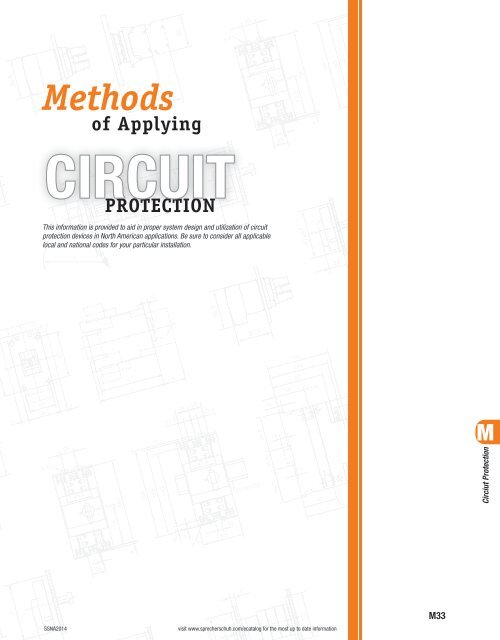
![Download Terms & Conditions of Sale [PDF] - Sprecher + Schuh](https://img.yumpu.com/51208389/1/190x245/download-terms-conditions-of-sale-pdf-sprecher-schuh.jpg?quality=85)

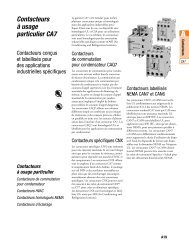


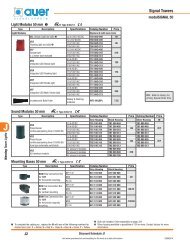
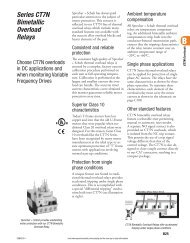
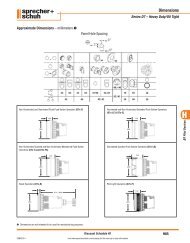
![PF Softstarter User manual [PDF] - Sprecher + Schuh](https://img.yumpu.com/48207512/1/190x245/pf-softstarter-user-manual-pdf-sprecher-schuh.jpg?quality=85)

